Low-Complexity MUSIC-Based Direction-of-Arrival Detection Algorithm for Frequency-Modulated Continuous-Wave Vital Radar
Abstract
1. Introduction
2. System Models and Trade-Off between FOV and Resolution
2.1. System Model
2.2. FOV and Resolution in DOA Estimation
3. Frequency-Estimation Algorithms
3.1. FFT-Based Algorithm for DOA Detection
3.2. MUSIC Algorithm
4. Proposed Low-Complexity MUSIC Algorithm
5. Simulation Results
5.1. Performance Evaluation
5.2. Complexity Comparison
6. Experiments
6.1. Experiment Setup
6.2. Experiment Results
7. Conclusions
Author Contributions
Funding
Conflicts of Interest
References
- Mahafza, B.R. Radar Systems Analysis and Design Using MATLAB, 3rd ed.; CRC Press: Boca Raton, FL, USA, 2013. [Google Scholar]
- Richards, M.A. Fundementals of Radar Signal Processing; Tata McGraw-Hill Education: New York, NY, USA, 2005. [Google Scholar]
- Levanon, N. Radar Signals, 1st ed.; Wiley: New York, NY, USA, 2004. [Google Scholar]
- Omer, A.E.; Safave-Naeini, S.; Hughson, R.; Shaker, G. Blood Glucose Level Monitoring Using an FMCW Millimeter-Wave Radar Sensor. Remote Sens. 2020, 12, 385. [Google Scholar] [CrossRef]
- Khan, F.; Ghaffar, A.; Khan, N.; Cho, S.H. An Overview of Signal Processing Techniques for Remote Health Monitoring Using Impulse Radio UWB Transceiver. Sensors 2020, 20, 2479. [Google Scholar] [CrossRef]
- Kim, S.; Lee, K.K. Low-Complexity Joint Extrapolation-MUSIC-Based 2-D Parameter Estimator for Vital FMCW Radar. IEEE Sens. J. 2019, 19, 2205–2216. [Google Scholar] [CrossRef]
- Aldhaeebi, M.A.; Alzoubi, K.; Almoneef, T.S.; Bamatraf, S.M.; Attia, H.; Ramahi, O.M. Review of Microwaves Techniques for Breast Cancer Detection. Sensors 2020, 20, 2390. [Google Scholar] [CrossRef]
- Islam, S.M.M.; Boric-Lubecke, O.; Lubekce, V.M. Concurrent respiration monitoring of multiple subjects by phase-comparison monopulse radar using independent component analysis (ICA) with JADE algorithm and direction of arrival (DOA). IEEE Access 2020, 8, 73558–73569. [Google Scholar] [CrossRef]
- Narayanan, R.M.; Dawood, M. Doppler estimation using a coherent ultrawide-band random noise radar. IEEE Trans. Antennas Propag. 2000, 48, 868–878. [Google Scholar] [CrossRef]
- Sun, R.; Zhang, W.; Yao, B. Frame arrival detection for low SNR frequency selective fading channels. In Proceedings of the 2018 IEEE/CIC International Conference on Communications in China (ICCC), Beijing, China, 16–18 August 2018; pp. 374–378. [Google Scholar]
- Alejos, A.V.; Sanchez, M.G.; Lglesias, D.R.; Cuiñas, I. Performance analysis of angle diversity for direction finding in 2.4 GHz tracking applications. IEEE Trans. Wirel. Commun. 2012, 6, 147–156. [Google Scholar] [CrossRef]
- Zhang, W.; Yin, Q.; Chen, H.; Gao, F.; Ansari, N. Distributed angle estimation for localization in wireless sensor networks. IEEE Trans. Wirel. Commun. 2013, 12, 527–537. [Google Scholar] [CrossRef]
- Stove, A.G. Linear FMCW radar techniques. IEEE Proc. Radar Signal Process. 1992, 139, 343–350. [Google Scholar] [CrossRef]
- Dudek, M.; Nasr, I.; Bozsik, G.; Hamouda, M.; Kissinger, D.; Fischer, G. System analysis of a phased-array radar applying adaptive beam-control for future automotive safety applications. IEEE Trans. Veh. Tech. 2015, 64, 34–47. [Google Scholar] [CrossRef]
- Saponara, S.; Neri, B. Radar sensor signal acquisition and multidimensional FFT processing for surveillance applications in transport systems. IEEE Trans. Instrum. Meas. 2017, 66, 604–615. [Google Scholar] [CrossRef]
- Matthew, A.; Matthew, R.; Kevin, C. On the application of digital moving target indication techniques to short-range FMCW radar data. IEEE Sens. J. 2017, 18, 4167–4175. [Google Scholar]
- Jin, Y.; Kim, B.; Kim, S.; Lee, J. Design and Implementation of FMCW Surveillance Radar Based on Dual Chirps. Elektron. Ir Elektrotechnika 2018, 24, 60–66. [Google Scholar] [CrossRef]
- Son, Y.S.; Sung, H.K.; Heo, S.W. Automotive frequency modulated continuous wave radar interference reduction using per-vehicle chirp sequences. Sensors 2018, 18, 2831. [Google Scholar] [CrossRef]
- Li, Y.C.; Oh, D.; Kim, S.; Chong, J.W. Dual channel S-band frequency modulated continuous wave through-wall radar imaging. Sensors 2018, 18, 311. [Google Scholar] [CrossRef]
- Kim, B.; Kim, S.; Lee, J. A novel DFT-based DOA estimation by a virtual array extension using simple multiplications for FMCW radar. Sensors 2018, 18, 1560. [Google Scholar] [CrossRef]
- Zhang, W.; He, N.; He, Z.; Han, M. Approach of 2D direction of arrival estimation of FMCW traffic radar by utilising 1D array. Electron. Lett. 2020, 56, 97–99. [Google Scholar] [CrossRef]
- Wang, Y.; Li, Y.; Yang, X.; Zhou, M.; Tian, Z. A Novel Low-Complexity Joint Range-Azimuth Estimator for Short-Range FMCW Radar System. In Proceedings of the International Conference in Communications, Signal Processing, and Systems, Urumqi, China, 20 July 2019; Springer: Singapore, 2019. [Google Scholar]
- Li, Y.; Zhang, C.; Song, Y.; Huang, Y. Enhanced beamspace MUSIC for cost-effective FMCW automotive radar. IET Radar Sonar Navig. 2020, 14, 257–267. [Google Scholar] [CrossRef]
- Kim, S.; Kim, B.; Jin, Y.; Lee, J. Extrapolation-RELAX estimator based on spectrum partitioning for DOA estimation of FMCW radar. IEEE Access 2019, 7, 98771–98780. [Google Scholar] [CrossRef]
- Liu, H.; Li, B.; Yuan, X.; Zhou, Q.; Huang, J. A Robust real time direction-of-arrival estimation method for sequential movement events of vehicles. Sensors 2018, 18, 992. [Google Scholar] [CrossRef]
- Dawood, M.; Quraishi, N.; Alejos, A.V. Superresolution Doppler estimation using UWB random noise noise singals and MUSIC. IEEE Trans. Aerosp. Electron. Syst. 2013, 49, 325–340. [Google Scholar] [CrossRef]
- Nie, W.; Xu, K.; Feng, D.; Wu, C.Q.; Hou, A.; Yin, X. A fast algorithm for 2D DOA estimation using an omnidirectional sensor array. Sensors 2017, 17, 515. [Google Scholar] [CrossRef] [PubMed]
- Basikolo, T.; Arai, H. APRD-MUSIC algorithm DOA estimation for reactance based uniform circular array. IEEE Trans. Antennas Propag. 2016, 64, 4415–4422. [Google Scholar] [CrossRef]
- Li, B.; Wang, S.; Zhang, J.; Cao, X.; Zhao, C. Fast MUSIC Algorithm for mm-Wave Massive-MIMO Radar. arXiv 2019, arXiv:1911.07434. [Google Scholar]
- Schmidt, R.O. Multiple emitter location and signal parameter estimation. IEEE Trans. Antennas Propag. 1986, 34, 276–280. [Google Scholar] [CrossRef]
- Li, J.; Jiang, D.; Zhang, X. DOA estimation based on combined unitary ESPRIT for coprime MIMO radar. IEEE Commnun. Lett. 2017, 21, 96–99. [Google Scholar] [CrossRef]
- Meng, Z.; Zhou, W. Direction-of-Arrival Estimation in Coprime Array Using the ESPRIT-Based Method. Sensors 2019, 3, 707. [Google Scholar] [CrossRef]
- Hu, C.; Wang, J.; Tian, W.; Zeng, T.; Wang, R. Design and Imaging of Ground-Based Multiple-Input Multiple-Output Synthetic Aperture Radar (MIMO SAR) with Non-Collinear Arrays. Sensors 2017, 17, 598. [Google Scholar] [CrossRef]
- Baig, N.A.; Malik, M.B. Comparison of Direction of Arrival (DOA) Estimation Techniques for Closely Spaced Targets. Proc. Int. J. Future Comput. Commun. 2013, 2, 654. [Google Scholar] [CrossRef]
- Kim, B.; Kim, S.; Jin, Y.; Lee, J. A low-complexity FMCW surveillance radar algorithm using two random beat signals. Sensors 2018, 19, 608. [Google Scholar] [CrossRef]
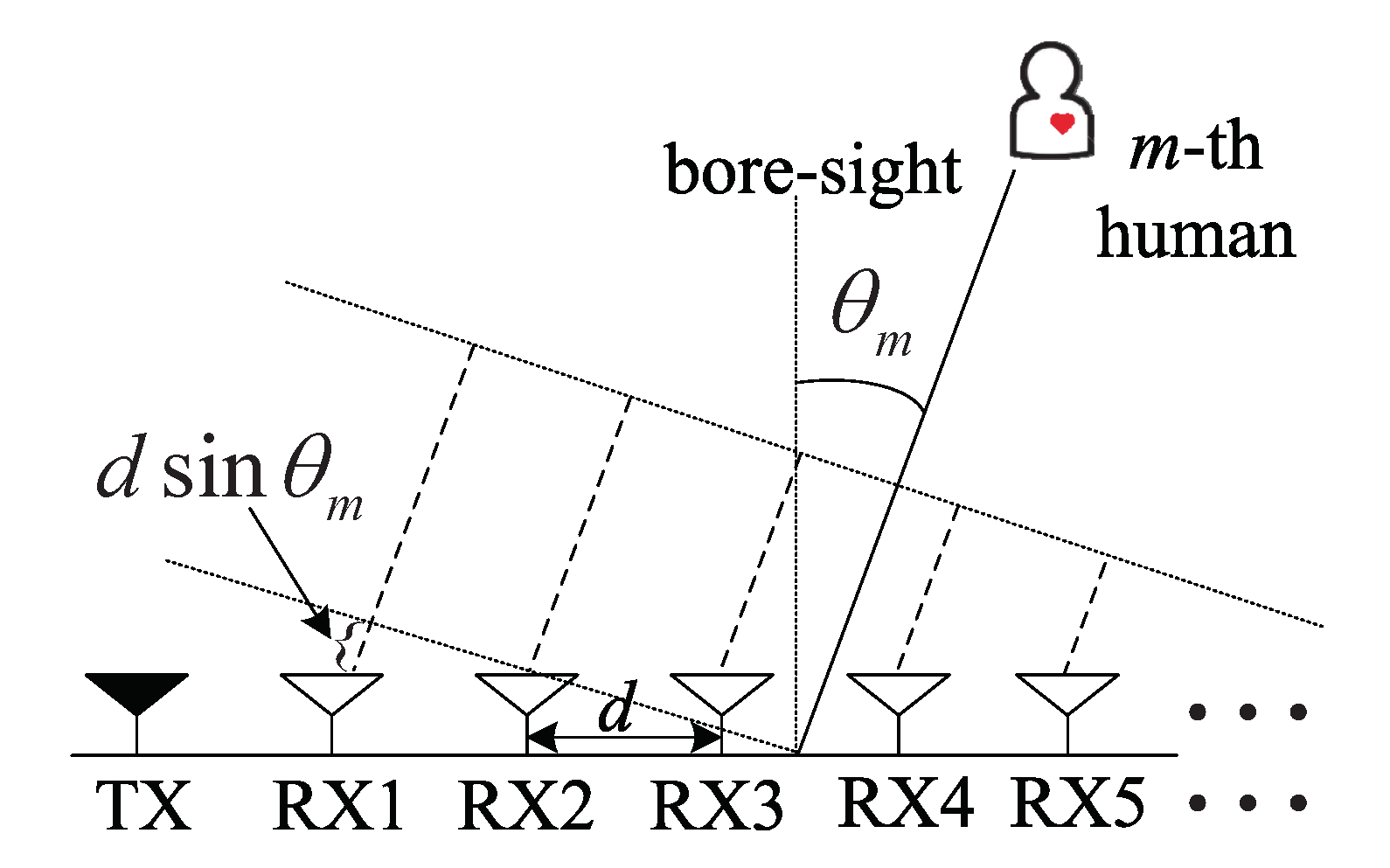

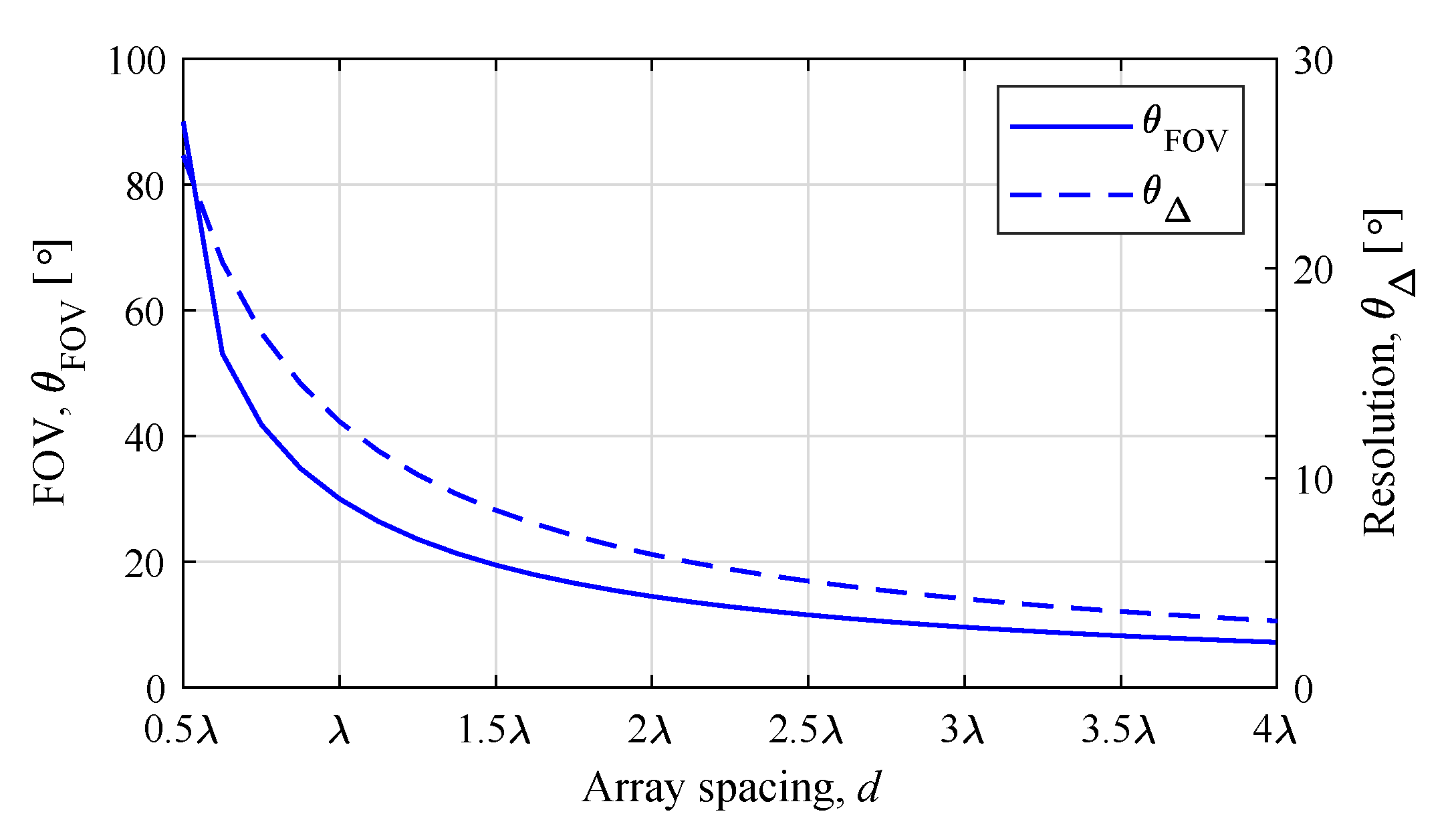
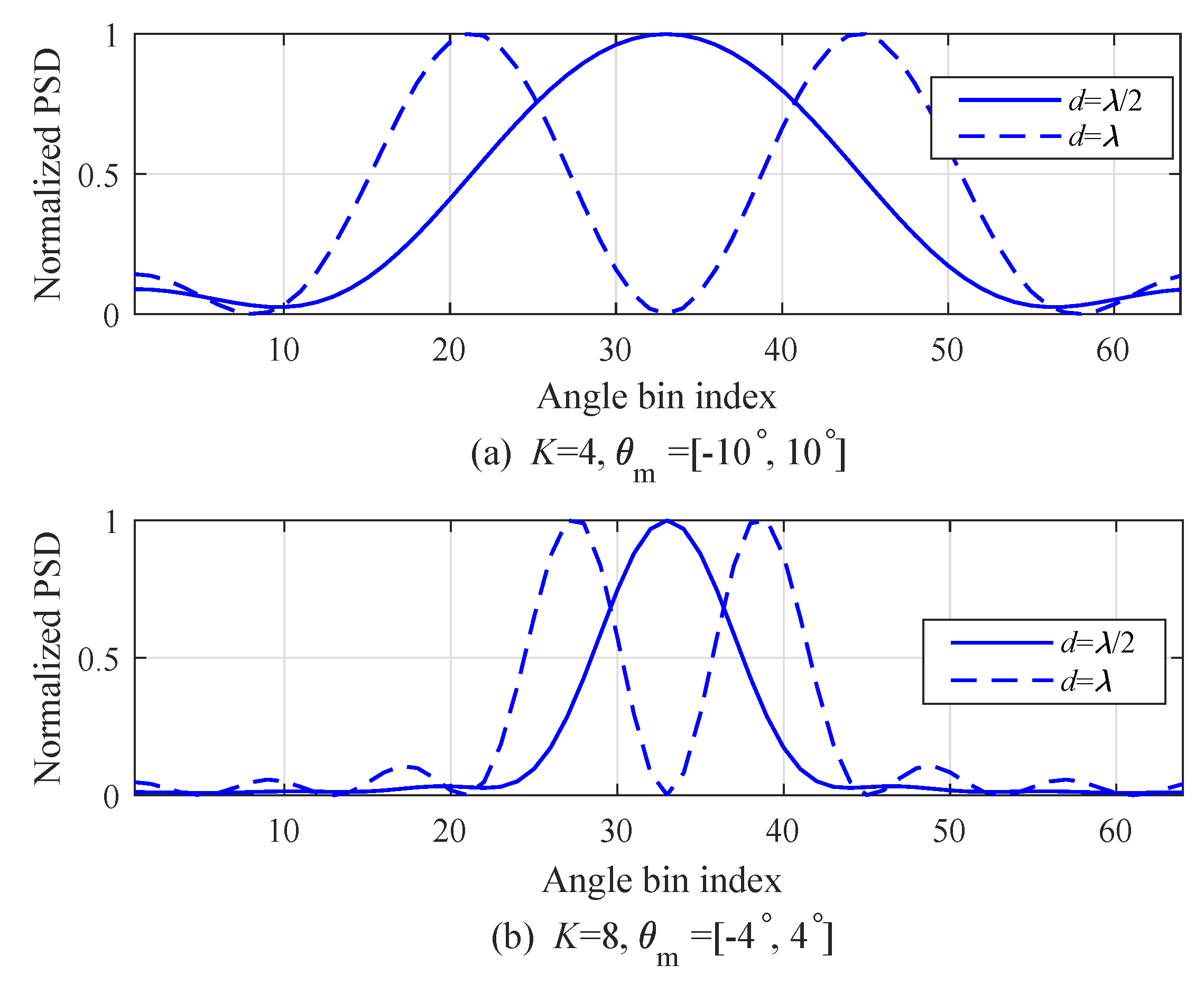
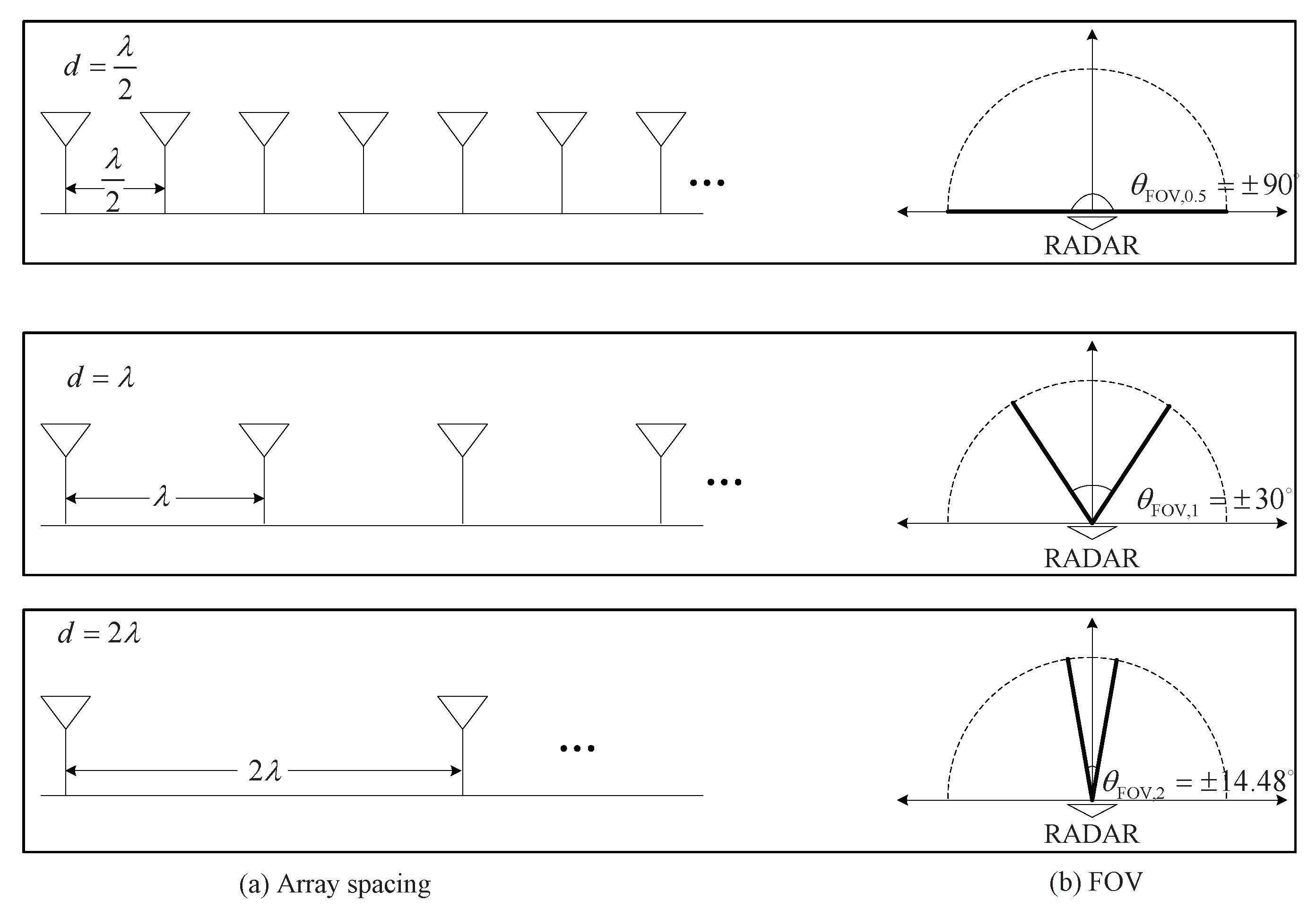
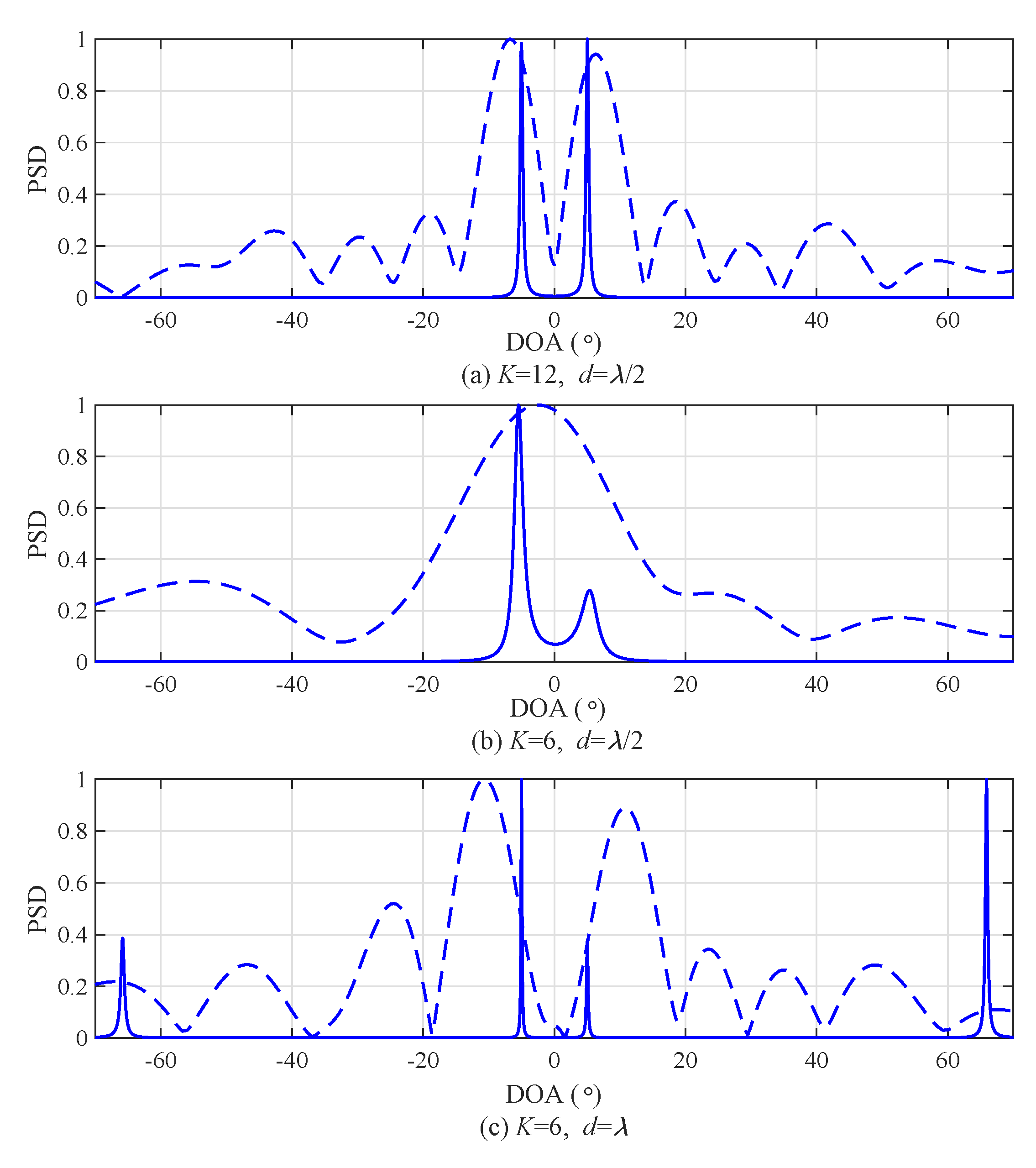

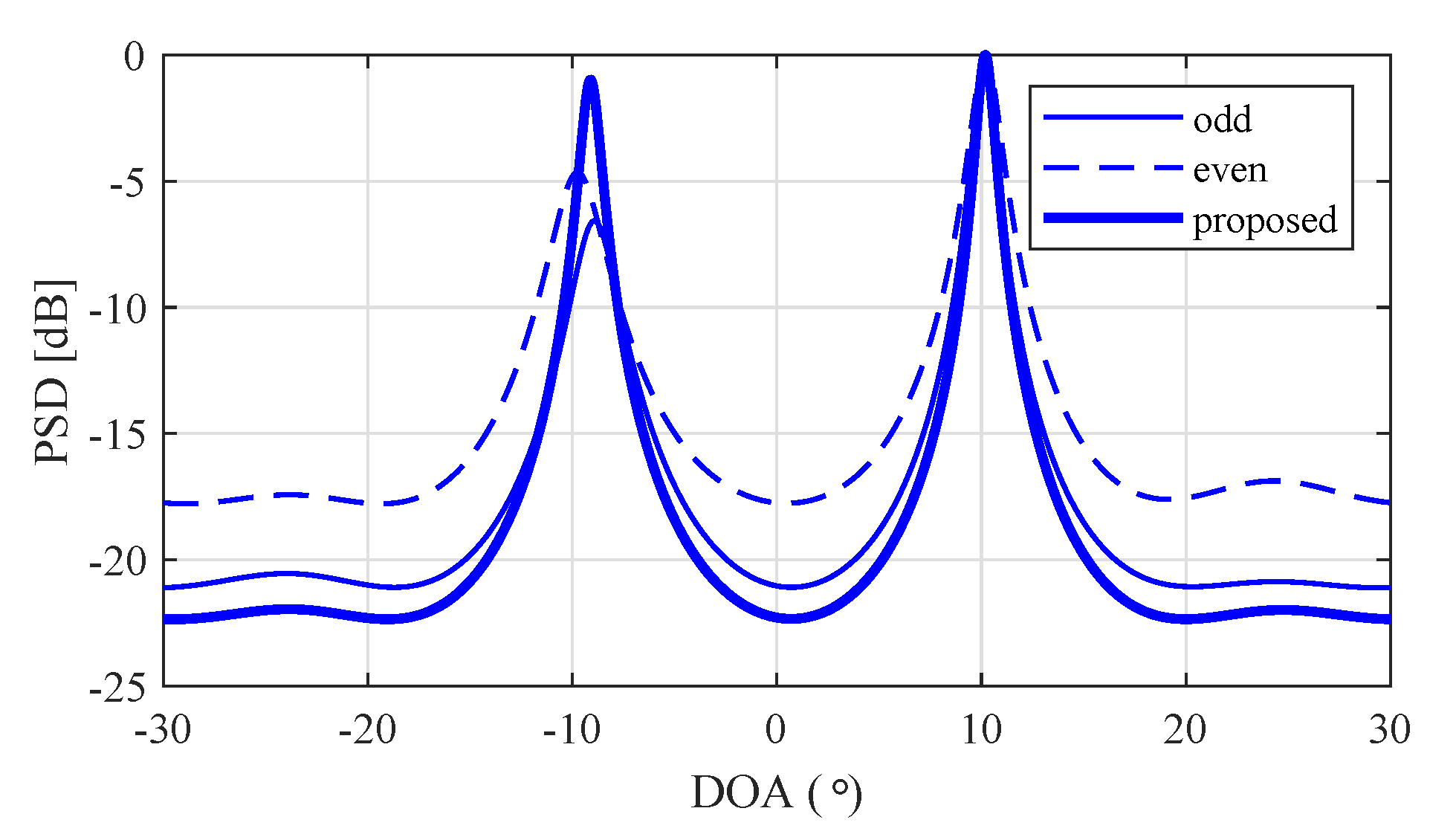
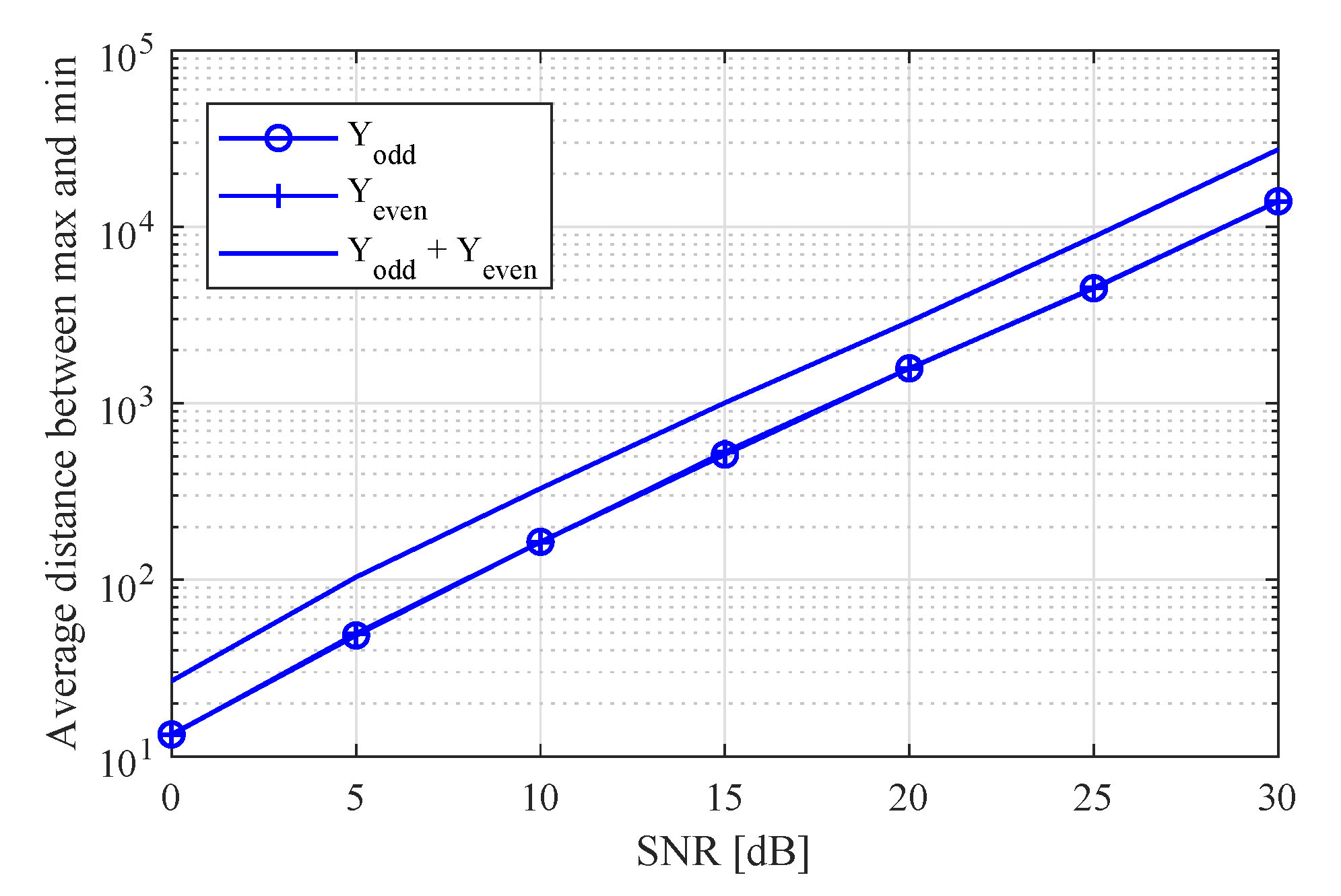

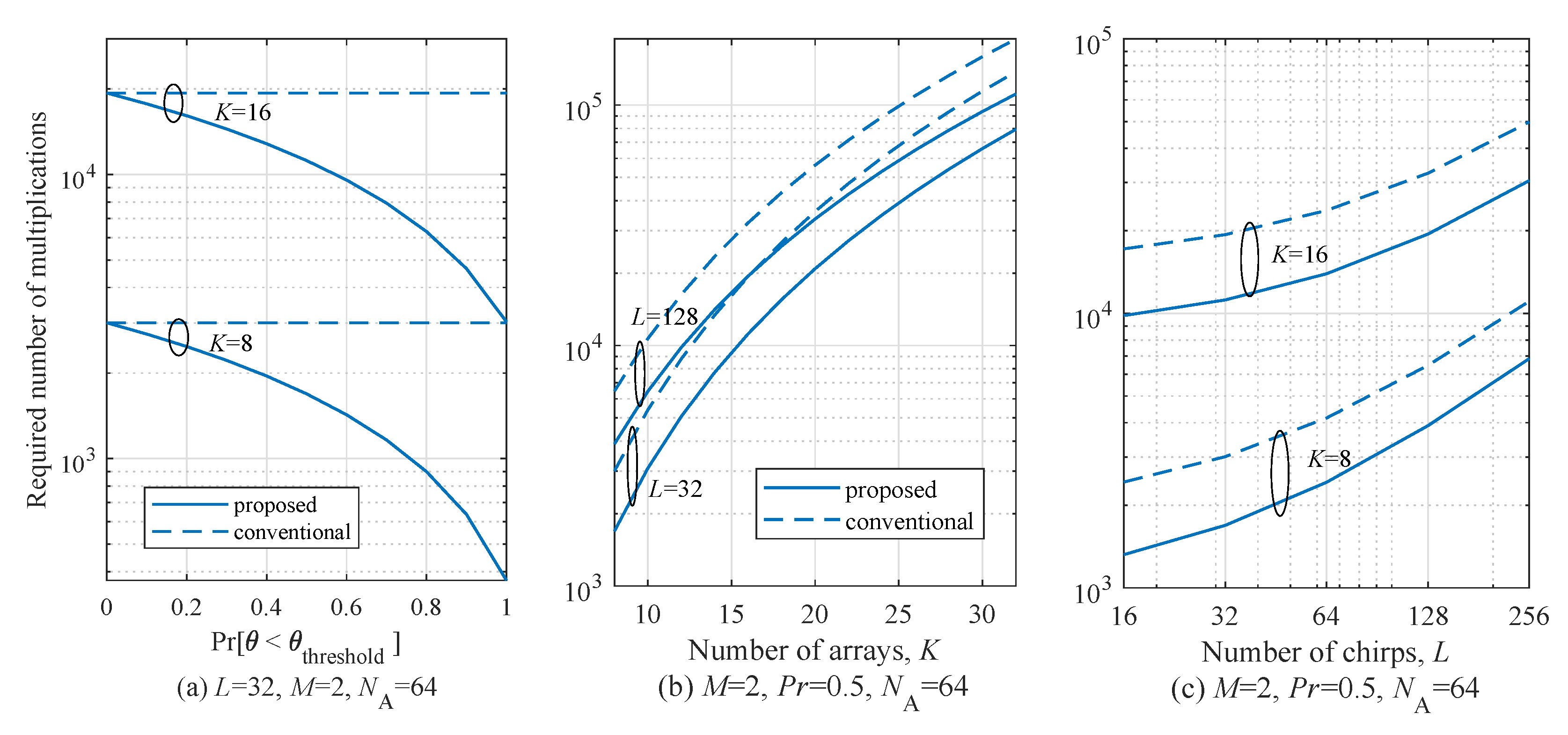
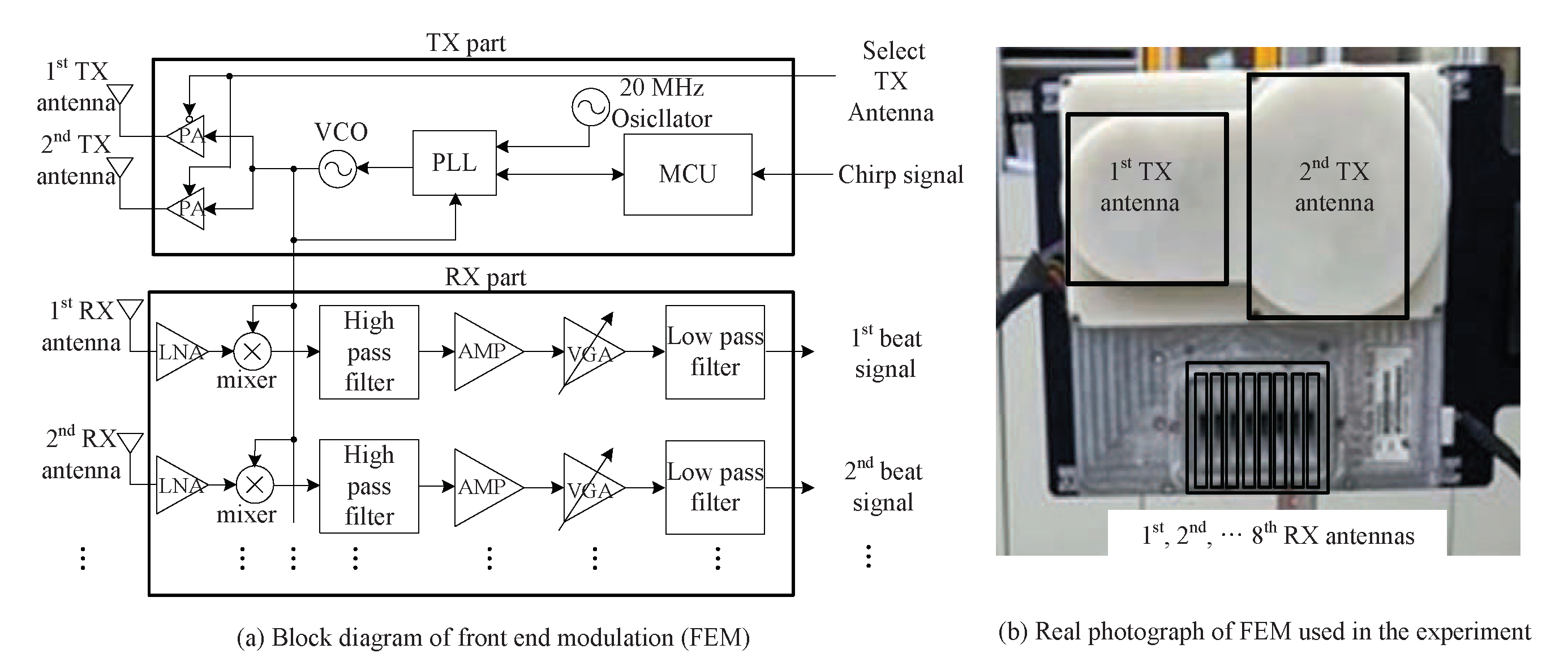

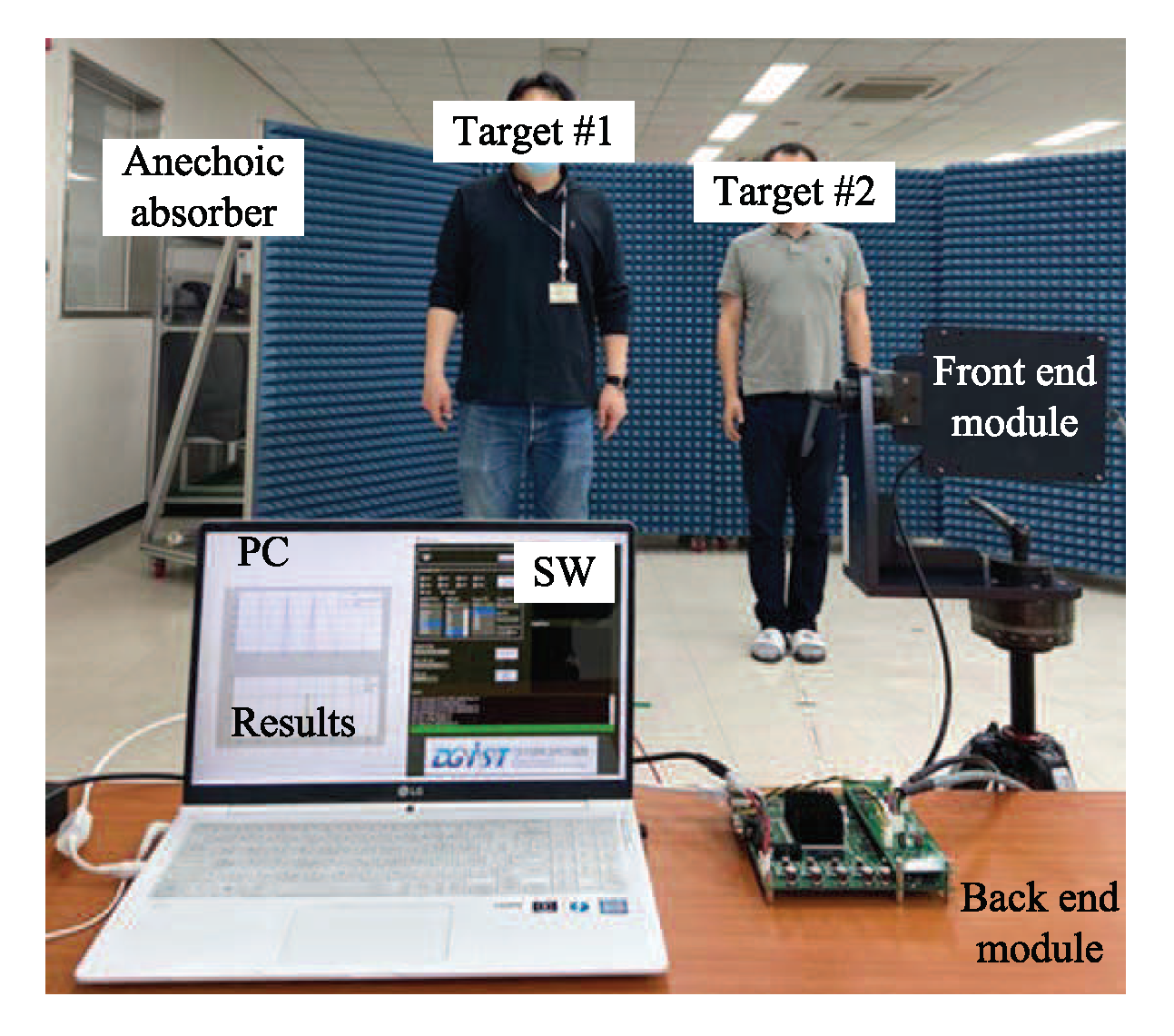

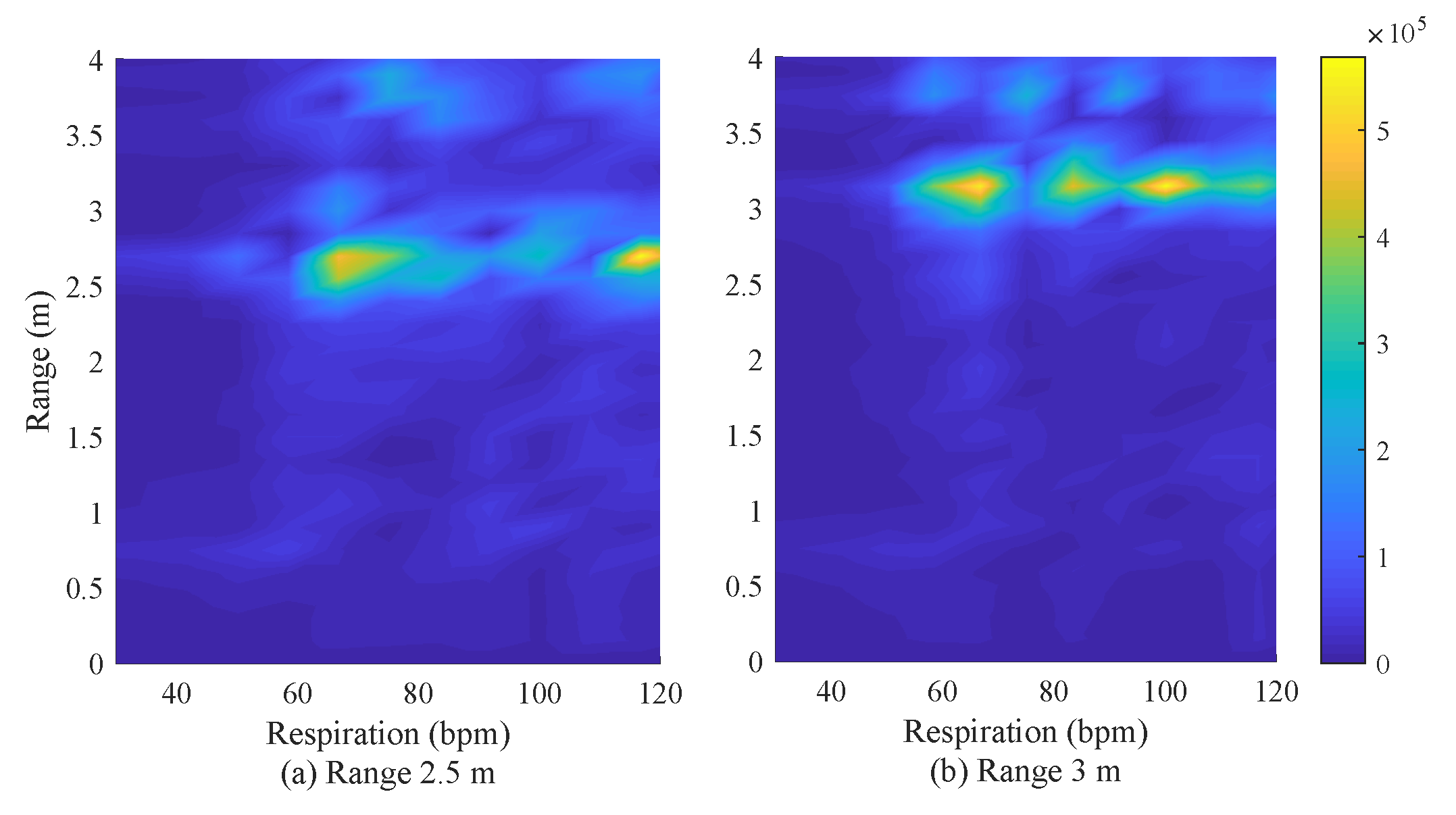
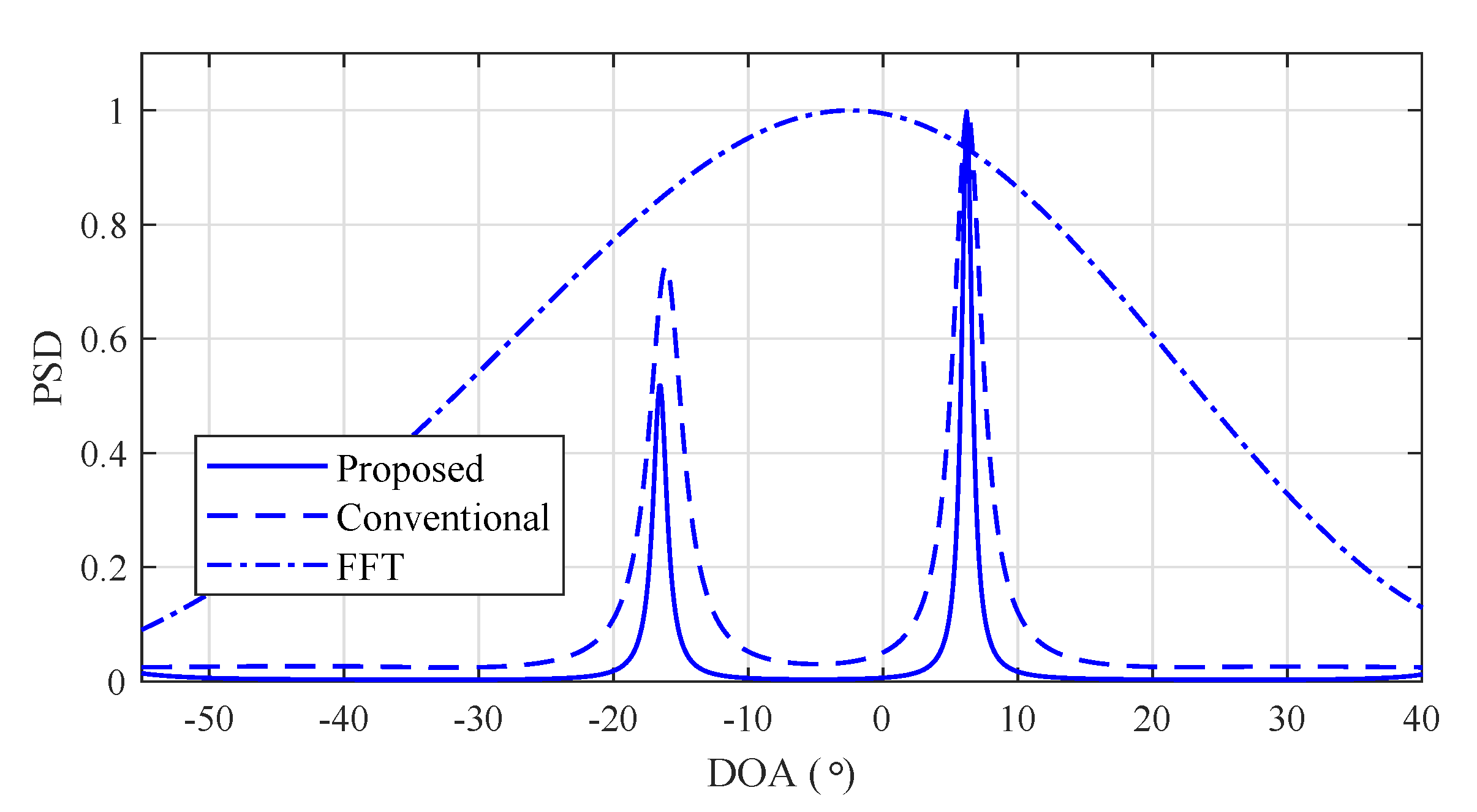
| Operation | Equation | Required Number of Multiplications |
|---|---|---|
| Generation of covariance matrix | ||
| SVD calculation | ||
| Noise-subspace generation | ||
| Pseudospectrum calculation |
© 2020 by the authors. Licensee MDPI, Basel, Switzerland. This article is an open access article distributed under the terms and conditions of the Creative Commons Attribution (CC BY) license (http://creativecommons.org/licenses/by/4.0/).
Share and Cite
Kim, B.-s.; Jin, Y.; Lee, J.; Kim, S. Low-Complexity MUSIC-Based Direction-of-Arrival Detection Algorithm for Frequency-Modulated Continuous-Wave Vital Radar. Sensors 2020, 20, 4295. https://doi.org/10.3390/s20154295
Kim B-s, Jin Y, Lee J, Kim S. Low-Complexity MUSIC-Based Direction-of-Arrival Detection Algorithm for Frequency-Modulated Continuous-Wave Vital Radar. Sensors. 2020; 20(15):4295. https://doi.org/10.3390/s20154295
Chicago/Turabian StyleKim, Bong-seok, Youngseok Jin, Jonghun Lee, and Sangdong Kim. 2020. "Low-Complexity MUSIC-Based Direction-of-Arrival Detection Algorithm for Frequency-Modulated Continuous-Wave Vital Radar" Sensors 20, no. 15: 4295. https://doi.org/10.3390/s20154295
APA StyleKim, B.-s., Jin, Y., Lee, J., & Kim, S. (2020). Low-Complexity MUSIC-Based Direction-of-Arrival Detection Algorithm for Frequency-Modulated Continuous-Wave Vital Radar. Sensors, 20(15), 4295. https://doi.org/10.3390/s20154295





